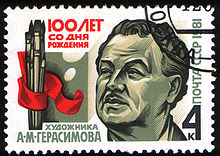Oil Painting » List of Painters » Aleksandr Gerasimov
EARLY DAYS:
Aleksandr Gerasimov was born in 1881 in the village of Staraya Ladoga in St. Petersburg, Russia. He was the son of a peasant and was raised in a strict religious environment, something that would shape his outlook throughout his life. He was educated at the Imperial Academy of Arts from 1901-1904, and from there he was sent to study at the studio of Dmitry Kardovsky.
Gerasimov had a natural talent for art and soon developed his skill in depicting everyday life in Russia. He was one of the first Russian painters to embrace a new style of painting called "social realism" which focused on the struggles and hardships of the common people. His works portrayed the harshness of the Russian Revolution and often featured scenes of violence, poverty and despair.
Gerasimov was also one of the first artists to explore the concept of symbolism in his art. He used symbols to convey deeper meanings and to highlight the suffering of the oppressed. He gained a reputation as a dedicated and passionate artist and won a number of awards, including the Order of Lenin and theOrder of the Red Banner.
Gerasimov's most famous works include "The March of the Red Army" and "The Funeral of a Soldier". Both of these works depicted a genre of art that was unique to Russia and which had never been seen before. His art was also a response to the political and social changes that were taking place in Russia during this period.
Gerasimov's work was hugely influential and he is still remembered today as one of the most important artists of the 20th century. His works continue to be exhibited around the world and his legacy of social realism and symbolism lives on.

Personal Details
| Name | Aleksandr Gerasimov |
| Place of birth | Kozlov, Russian Empire |
| Date of Birth | 12 August 1881 |
| Date of Death | 23 July 1963 |
| Nationality | Russian, Soviet |
| Field | Moscow School of Painting, Sculpture and Architecture |
CAREER:
In 1929,Aleksandr Gerasimov began exhibiting his work for the first time, and it was well received. He soon joined the Association of Artists of Revolutionary Russia and became its vice president in 1932. During this time, he was able to travel to Europe and the United States, where he was exposed to a variety of new artistic styles.
In the 1930s, Gerasimov's career shifted towards more official government-related art. He was commissioned to create a series of propaganda posters for the Soviet government, which he did with great success. These posters were widely circulated and helped to shape the Soviet public's perception of the government.
During World War II, Gerasimov was involved in the defense of his homeland, creating a series of propaganda posters for the war effort. After the war, he returned to creating art for the government, this time focusing on the Communist Party's official ideals. His work during this period was often praised for its realistic portrayal of Soviet life.
In the 1950s, Gerasimov shifted his focus towards more traditional art, creating portraits and landscapes that reflected the beauty of the Russian countryside. During this time, his works were exhibited in countries around the world, and he was even awarded the Lenin Prize for his artistic achievements.
In the 1960s, Gerasimov began experimenting with abstract art, a style which was unusual for the time. He was able to combine his traditional painting style with a more modern approach, creating works that were both aesthetically pleasing and thought-provoking. His work during this period was highly praised, and he was even awarded the Order of the Badge of Honor in 1968.
Aleksandr Gerasimov's career spanned more than six decades, and during this time he created a vast number of works that have gone on to become iconic pieces of Russian art. He passed away in 1993, but his legacy as one of the most influential Russian artists of the 20th century lives on.



